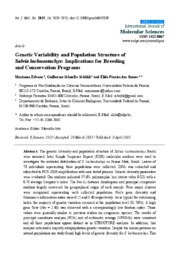Genetic variability and population structure of Salvia lachnostachys: implications for breeding and conservation programs.
Genetic variability and population structure of Salvia lachnostachys: implications for breeding and conservation programs.
Author(s): ERBANO, M.; SCHUHLI, G. S. e; SANTOS, É. P. dos
Summary: The genetic diversity and population structure of Salvia lachnostachys Benth were assessed. Inter Simple Sequence Repeat (ISSR) molecular markers were used to investigate the restricted distribution of S. lachnostachys in Parana State, Brazil. Leaves of 73 individuals representing three populations were collected. DNA was extracted and submitted to PCR-ISSR amplification with nine tested primers. Genetic diversity parameters were evaluated. Our analysis indicated 95.6% polymorphic loci (stress value 0.02) with a 0.79 average Simpson?s index. The Nei-Li distance dendrogram and principal component analysis largely recovered the geographical origin of each sample. Four major clusters were recognized representing each collected population. Nei?s gene diversity and Shannon?s information index were 0.25 and 0.40 respectively. As is typical for outcrossing herbs, the majority of genetic variation occurred at the population level (81.76%). A high gene flow (Nm = 2.48) was observed with a correspondingly low fixation index. These values were generally similar to previous studies on congeneric species. The results of principal coordinate analysis (PCA) and of arithmetic average (UPGMA) were consistent and all three populations appear distinct as in STRUCTURE analysis. In addition, this analysis indicated a majority intrapopulation genetic variation. Despite the human pressure on natural populations our study found high levels of genetic diversity for S. lachnostachys. This was the first molecular assessment for this endemic species with medicinal proprieties and the results can guide for subsequent bioprospection, breeding programs or conservation actions.
Publication year: 2015
Types of publication: Journal article
Unit: Embrapa Forestry
Observation
Some of Embrapa's publications are published as ePub files. To read them, use or download one of the following free software options to your computer or mobile device. Android: Google Play Books; IOS: iBooks; Windows and Linux: Calibre.
Access other publications
Access the Agricultural Research Database (BDPA) to consult Embrapa's full library collection and records.
Visit Embrapa Bookstore to purchase books and other publications sold by Embrapa.

